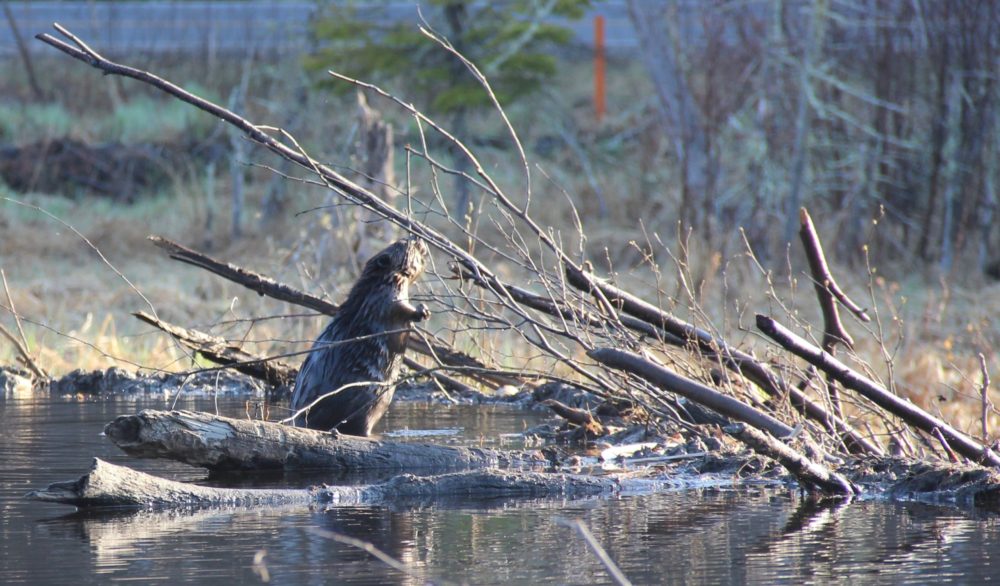 In Eager: The Surprising, Secret Life of Beavers and Why They Matter, award-winning environmental author Ben Goldfarb reveals that our modern idea of a healthy landscape is wrong, distorted by the fur trade that trapped out millions of beavers from North America’s lakes and rivers. The consequences of losing beavers were profound: streams eroded, wetlands dried up, and species from brook trout to trumpeter swans lost vital habitat. Today, a growing coalition of “Beaver Believers”―including scientists, ranchers, and passionate citizens―recognizes that ecosystems with beavers are far healthier, for humans and non-humans alike, than those without them.
In Eager: The Surprising, Secret Life of Beavers and Why They Matter, award-winning environmental author Ben Goldfarb reveals that our modern idea of a healthy landscape is wrong, distorted by the fur trade that trapped out millions of beavers from North America’s lakes and rivers. The consequences of losing beavers were profound: streams eroded, wetlands dried up, and species from brook trout to trumpeter swans lost vital habitat. Today, a growing coalition of “Beaver Believers”―including scientists, ranchers, and passionate citizens―recognizes that ecosystems with beavers are far healthier, for humans and non-humans alike, than those without them.
In his virtual presentation for GMC on Tuesday, May 26th, from 7:00 PM – 8:00 PM, Goldfarb will describe beaver biology, ecology, and history; detail the many environmental benefits provided by beavers, including habitat creation, water storage, and pollution filtration; and explain how landowners and municipalities around the country are learning to coexist with these invaluable rodents. Below, find an excerpt from his book on how removing beavers severely altered the historical New England landscape:

For more than two centuries, a conquering army of white trappers and traders had ravaged beavers in every stream and pond they encountered, leaving ruins in their wake. Beaver numbers in New England began tapering off as early as the mid-1600s; by the eighteenth century, Massachusetts was beaver-free. Connecticut, Vermont, and several other northeastern states soon joined the ranks of the beaverless. Among those who bemoaned the destruction was Thoreau; the hermit, who considered beavers one of the “nobler” animals, wrote that the rodent’s destruction, along with the eradication of cougars, bears, moose, and other species, had “emasculated” the Northeast.
If the first wave of trappers encountered a continent molded by beavers, the farmers and settlers who followed met a landscape shaped by their absence. “The elimination of the beaver . . . left New England with a wealth of place names that no longer made much sense: scattered across the map of the region one still finds Beaver Brooks, Beaver Stations, Beaver Creeks, and Beaver Ponds,” wrote William Cronon in Changes in the Land. And that’s just English: Ahmeek, Michigan; Capa, South Dakota; and Kinta, Oklahoma, all derive their names from native words for beaver.
For all the nomenclatural upheaval, the ecological repercussions were far more severe. Many beaver-formed wetlands are inherently liminal, transitioning ceaselessly from one state to the next; a beaver complex is one of the few opportunities we mortals have to watch geological processes unfold within the duration of a single human life span. Often the progression runs from water to earth, as beaver ponds slow flows, trap sediment, and gradually fill with silt and pioneering plants, whereupon their creators move upstream to begin the cycle again. Left behind are open, grass-filled meadows—their surfaces flat, treeless, and flan-like underfoot, bermed with the overgrown contours of long-ago dams. The fecundity of these sunlit havens wasn’t lost on hunters. “Beaver meadows are splendid feeding grounds for deer and other animals,” remarked James Campbell Lewis, a hunter and trapper who went by the name Black Beaver. “I have seen beaver meadows . . . covering hundreds of acres.”
When trappers de-beavered North America, they threw that natural evolution into fast forward. As dams deteriorated and ponds drained, they left behind some of the finest soil a farmer could till, a newly exposed mélange of “leaves, bark, rotten wood and other manure,” as Jeremy Belknap put it in his History of New Hampshire. “The whole tract, which before was the bottom of a pond, is covered with wild grass, which grows as high as a man’s shoulders, and very thick. . . . Without these natural meadows, many settlements could not possibly have been made.” An English traveler named Henry Wansey corroborated the account. “It is a fortunate circumstance to have purchased lands where these industrious animals have made a settlement,” Wansey wrote. “At some of them, there have been four ton of hay cut at an acre.” When beavers were trapped out of the American Southwest more than a century later, the abrupt dam failures released so much water that the Gila River Pima Indians recorded the first major flood in their oral history.
To understand how dramatically landscapes unraveled in beavers’ absence, consider the research of Johan Varekamp. Varekamp, a lean, fast-talking Netherlands native, is a geochemist at Wesleyan University in Middletown, Connecticut; his wife, Ellen Thomas, is a micropaleontologist at nearby Yale. In the 1990s the duo organized a series of research cruises in Long Island Sound, the wedge of ocean that squeezes between Connecticut’s shoreline and the tapering moraine of Long Island. Using a bottom-penetrating coring tube, Varekamp and Thomas hauled up cylindrical samples of muck, which they analyzed for everything from pollen to salinity. But it was the mercury concentrations, which spiked near the mouth of the Housatonic River, that grabbed their attention.
The source, they learned, was the city of Danbury, a former capital of fur hat manufacturing. Hatmaking once entailed an act of appalling chemistry: Hatters brushed beaver or rabbit pelts with mercury nitrate, an orange solution that matted fur into malleable felt. Many hatters who handled the potent neurotoxin suffered from mental fogginess and uncontrollable twitching—a disorder, known as the Danbury Shakes, that likely spawned the idiom mad as a hatter. Not until 1941, after years of worker advocacy, did the state finally ban mercury’s use in hatting. By then the damage to human health and the environment had been done: On the grounds of one former hat factory, Varekamp found that mercury concentrations remained triple the state’s standard.
But Varekamp’s rodent-related investigations had only begun—for it wasn’t just the fur trade that left behind its signature in the Long Island Sound’s sediment, but New England’s beavers themselves. When he and Thomas examined their layers of muck, they found that diatoms, a kind of silica-based algae, had exploded around 1800. That made sense: Expanding European colonies and their livestock would have fouled the sound’s waterways with runoff around that time, fertilizing the ocean with nitrogen-rich waste and birthing algal blooms. To their surprise, however, they also found evidence of an earlier spike in algae, in the late 1600s, that appeared to be unrelated to human population. Varekamp scoured history for an explanation. He remembered mercury; he thought about hats and pelts and, finally, beavers.
The story, he told me, goes something like this. Southern New England’s earliest European explorers—including Adriaen Block, Varekamp’s fellow Dutchman, who sailed to the region four times between 1611 and 1614—instantly realized its fur potential. By the mid-1600s around eighty thousand pelts were leaving the region each year, bound for Holland and England.47 As beavers vanished, the same epic collapse of unmaintained dams that created peerless farmland also conveyed massive quantities of pond sludge—decayed leaves, sticks, insects, and other detritus—to the sea. The result was a surge of fertilizer that Varekamp and Thomas termed the “beaver peak.” “You have all these beaver ponds that are ultimately going to hell,” Varekamp told me, “and all that decaying wood and organic matter ultimately leads to a flux of nutrients to the sound and a pulse of algal blooms.”
In other words: Beavers were so omnipresent, so influential, in the Northeast that their destruction can still be detected in the sea itself.
Colonists quickly choked New England with dams of their own, clogging Connecticut’s rivers alone with more than four thousand walls to power saw-, grist-, and paper mills. Even so, Varekamp said, Long Island Sound’s watershed still delivers several times more sediment to the sea than it did before white settlement. Partly that’s because deforestation destabilized soils and increased erosion; but partly it’s because, for all our dam building, we can’t hope to replicate the sediment-storing feats of our flat-tailed forebears. “Every secondary and tertiary river would have been totally dammed,” Varekamp said with a touch of melancholy. “It is hard to imagine what the overall landscape would have looked like—how gorgeous it was, how green, how lush.”
Don’t forget to join us on Tuesday, May 26th, from 7:00 PM – 8:00 PM for Goldfarb’s virtual presentation for GMC!



















Leave a Reply